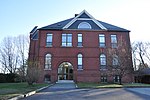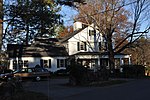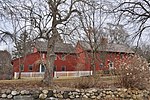Ballardvale, Massachusetts
Andover, MassachusettsUse mdy dates from July 2023Villages in Essex County, MassachusettsVillages in Massachusetts

Ballardvale (sometimes written archaically as BallardVale or Ballard Vale) is a village located within the boundaries of the town of Andover, Essex County, Massachusetts, United States. Growing originally in the 19th century around mills located on the Shawsheen River, the village is a local historic district, boasting many varieties of historic architecture and a rich industrial heritage.
Excerpt from the Wikipedia article Ballardvale, Massachusetts (License: CC BY-SA 3.0, Authors, Images).Ballardvale, Massachusetts
Marland Street,
Geographical coordinates (GPS) Address Nearby Places Show on map
Geographical coordinates (GPS)
| Latitude | Longitude |
|---|---|
| N 42.625 ° | E -71.160555555556 ° |
Address
Marland Street 6
01810
Massachusetts, United States
Open on Google Maps











